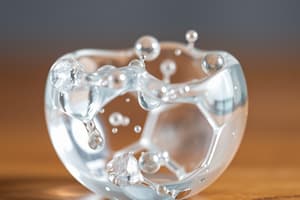Podcast
Questions and Answers
Which of the following best describes a solution?
Which of the following best describes a solution?
- A homogeneous mixture with only one visible phase. (correct)
- A mixture with visible layers.
- A mixture containing solid particles that settle over time.
- A cloudy mixture with suspended particles.
A mechanical mixture consists of two or more types of particles that are uniformly distributed.
A mechanical mixture consists of two or more types of particles that are uniformly distributed.
False (B)
What are the two types of pure substances?
What are the two types of pure substances?
Elements and compounds.
A __________ is a type of mixture where particles are evenly mixed but not dissolved.
A __________ is a type of mixture where particles are evenly mixed but not dissolved.
Match the following types of matter with their descriptions:
Match the following types of matter with their descriptions:
Which of the following is an example of a compound?
Which of the following is an example of a compound?
All mixtures can be classified as either mechanical mixtures or solutions.
All mixtures can be classified as either mechanical mixtures or solutions.
Give one example of a mechanical mixture.
Give one example of a mechanical mixture.
In a __________, you can often observe the individual components because it is heterogeneous.
In a __________, you can often observe the individual components because it is heterogeneous.
Which property is NOT associated with pure substances?
Which property is NOT associated with pure substances?
Which characteristic defines a mechanical mixture?
Which characteristic defines a mechanical mixture?
A solution is considered a heterogeneous mixture.
A solution is considered a heterogeneous mixture.
What is the primary difference between elements and compounds?
What is the primary difference between elements and compounds?
Examples of mechanical mixtures include __________ and nut mixes.
Examples of mechanical mixtures include __________ and nut mixes.
Which of the following is an example of a suspension?
Which of the following is an example of a suspension?
All pure substances can be separated into simpler substances.
All pure substances can be separated into simpler substances.
Describe what a solution is in terms of particle visibility.
Describe what a solution is in terms of particle visibility.
Sodium chloride (NaCl) is an example of a __________.
Sodium chloride (NaCl) is an example of a __________.
Which of the following properties is unique to pure substances?
Which of the following properties is unique to pure substances?
Flashcards
Pure substance
Pure substance
A substance made up of only one type of particle, having distinct properties like its melting point, boiling point, and color. It cannot be broken down into simpler substances by physical means.
Compound
Compound
A substance made up of two or more different elements chemically combined in a fixed ratio. These cannot be separated by physical means.
Element
Element
A substance that cannot be broken down into simpler substances by ordinary chemical means. Composed of only one type of atom.
Mechanical mixture
Mechanical mixture
Signup and view all the flashcards
Solution
Solution
Signup and view all the flashcards
Suspension
Suspension
Signup and view all the flashcards
Mixture
Mixture
Signup and view all the flashcards
Physical property
Physical property
Signup and view all the flashcards
Particle arrangement
Particle arrangement
Signup and view all the flashcards
Matter
Matter
Signup and view all the flashcards
Study Notes
Classification of Matter
- Matter is anything with mass and volume
- Matter is classified by its physical properties, such as state, color, size, shape, and smell
- Physical properties are determined by particle arrangement
- Matter is classified into mixtures and pure substances
Mixtures
-
Mixtures have two or more different types of particles
-
Three kinds of mixtures: mechanical mixtures, solutions, and suspensions
-
Mechanical mixtures are heterogeneous, noticeable layers/phases, with examples including salads, nut mixes, and spice mixes
-
Solutions are homogeneous, one layer/phase, often translucent. Examples include sugar dissolved in tea or coffee
-
Suspensions are heterogeneous, cloudy or opaque, with particles of one substance held within another. Examples include tomato juice
Pure Substances
- Pure substances have only one type of particle
- Pure substances have unique properties, such as melting point, boiling point, color, and hardness
- Two kinds of pure substances: elements and compounds
Elements
- Elements are the most pure kind of substance
- Elements cannot be broken down into anything simpler
- Elements are found on the periodic table
- Elements are made up of one kind of atom. Examples: oxygen (O2), iron (Fe), copper (Cu), and carbon (C)
Compounds
- Compounds are made by combining two or more different elements together
- Compounds are one kind of molecule
- Molecules are made of atoms/elements
- Example: sodium chloride (NaCl, or salt) is made up of sodium and chlorine atoms.
- Water (H₂O) is a compound made of hydrogen and oxygen atoms.
Studying That Suits You
Use AI to generate personalized quizzes and flashcards to suit your learning preferences.




